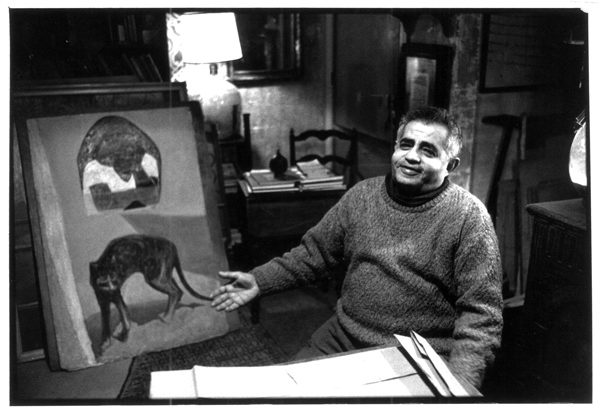
Born in 1928, Hassan Soliman graduated from Cairo’s School of Fine Arts in 1951. However, even before his graduation, Soliman’s skill as a draughtsman had drawn the attention of art critics and dealers, to the extent that one dealer offered him generous patronage in return for exclusive rights over what he produced.
In the Cairo art circles of the late 1940s and 50s, there was a rumor that this patron dealt in fakes and that Soliman had been asked to imitate the works of minor French impressionists on his behalf. When I asked Soliman about this ten years ago, he said he had only produced one fake Pissarro. However, he also told me and colleague Fayza Hassan, who was interviewing him for the Weekly in 1998, that he had been barely 20 years old when a rich Jewish businessman in Cairo provided him with a generous stipend, an atelier in Qasr El-Nil St., and an Italian housekeeper in return for his services.
As Fayza Hassan wrote in her 1998 interview, “It is perhaps one of Soliman’s minor eccentricities to insist upon his debt to Cairo’s foreign communities, the Jews in particular, who, according to him, guided his first steps towards eminence. Without their attentive patronage, says Soliman, he would never have become a known painter overnight when he was barely in his twenties.”
Yet, this period was a short one compared to Soliman’s career length. This spanned almost 60 years, and besides painting unceasingly, Soliman also wrote profusely on art and literature, founded and worked as a graphic designer on many avant-garde publications, taught at the Open University and the Cinema Institute, and contributed to Egypt’s cultural life in the 60s and 70s through his polemics on the role of art and the artist in society.
Upon graduating from the School of Fine Arts, Soliman moved to Luxor in 1952-53, where he worked as a painter in residence at the Luxor Atelier, a year which left an indelible mark on the composition of his work. In a recent obituary of Soliman, Mustafa El-Razaz, former Dean of the School of Fine Arts, commented that “rarely did Hassan Soliman draw an [specifically] Egyptian scene, but his work was very much Egyptian in its equanimity, like the ancient Egyptian reliefs carved on the walls of temples.”
In the early 1960s, Soliman went to Italy to study at the Accademia di Belle Arti di Brera in Milan. Before returning to Egypt, he toured Europe, visiting museums and art galleries, something he did annually for the rest of his life until his ailing health prevented him from traveling.
While in Paris during his first visit to Europe, Soliman received an offer to stay, and for a while, he seriously contemplated the idea before eventually deciding against it. A friend from Cairo, the francophone Egyptian novelist Albert Cossery, had taken up Paris a few years earlier. Something about what Soliman perceived as Cossery’s existential loneliness in the French capital made him go home.
Between the mid-1960s and the mid-1970s, Soliman was instrumental in almost every innovation introduced into the visual arts in Egypt. He joined Yehia Haqqi to produce the monthly cultural review al-Majalah, where he worked as layout editor and art critic. He was a graphic designer for numerous other avant-garde publications, including al-Katib and Gallery 68.
During the same period, Soliman also painted some of his most memorable works, including Work in the Field, The Seamstress, and Geese (reproductions of which can be seen on this page). However, by the mid-1970s, with the face of the country swiftly changing under the rule of Sadat, many of the cultural institutions that Soliman had immersed himself in so passionately were closing down, seen by the establishment as being run by potentially subversive leftists.
Hassan Soliman passed away quietly in 2008.